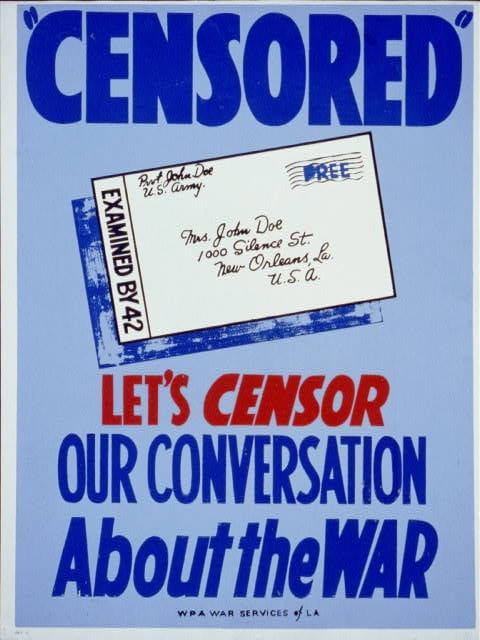Gallery
These are examples of the relics of information control efforts past and present, showcased in our exhibit and exhibit catalog. You can pick up a copy of the catalog from the University of Chicago Special Collections Research Center, or contact the assistant curator Julia Tomasson to request one by mail.
Celebrating Orwell
Orwell’s 1984, a commemorative edition put out in 2002 by Penguin, with the title and Orwell’s name blacked out as if censored, as a tribute to the book’s unique contributions to discourse about censorship.
The Censor’s Own Hand
Conrad Gesner’s famous sixteenth-century encyclopedia of animals, with the signature of a censor on the title page assuring that all its praise of Protestants has been expurgated.
Holy Censorship, Batman!
Batman #90, the first one to bear the seal “Approved by the Comics Code Authority” which censored American comic books from the 1950s to the end of the century.
Permission Required
“Imprimantur” i.e. let it be printed; in the 16th-18th centuries many European governments required all books to an “imprimantur” from official censors before anything was allowed to be printed.
Battle in the Margins
A student has filled the margins of this grammar textbook from the 1400s with lewd doodles, which a later user has attempted to erase with ink.
The Birth of Censorship
An ancient Papyrus leaf of Homer’s Iliad – the oldest endorsement of censorship in the historical record is Plato advocating censoring Homer’s depictions of the gods
The Infamous Index
From 1559 to 1966 the Catholic Index of Banned Books listed which works and authors were condemned, forbidden, or permitted only if selected passages were expurgated or destroyed.
Silencing Science
In these documents from 1949, atomic scientists express their concern about government regulation of their work, justified in the name of national security, but setting an alarming precedent for policing science in the classroom.
Icky Speech
This ultra-violent grotesque pornographic comic also contains a social commentary on the abuse of Japanese women during the post-war occupation, exemplifying how impossible it is to allow censorship of “icky” material without endangering valuable speech.
Censors’ Humor
Ordered by the Inquisition to erase the name of the condemned author if this treatise on logic, the censor has instead changed Balduino to Babboon, using humor instead of erasure.
Power Relations
In this page from “Twilight: Breaking Dawn” the mother of the under-age reader has blocked out the sex scene with sharpie and white-out, an act physically identical to Inquisition censors blacking text out of condemned books, but which feels very different because of the different power relationships involved.
Fake News in Shakespeare
Henry IV Part 2 has several sections concerned with Rumor and the proliferation of fake news, a hot topic during the pamphlet revolution Shakespeare’s audience was experiencing.
Censoring the Censor
This bowdlerized edition of Petrarch’s poetry replaced the most racy lines in this poem about prostitutes visiting the pope. The owner of this copy pasted over the altered verses to write the original back in, thus destroying the original poetic substitute verses composed by the censor.
Censorship in Education
This page comes from a collection of documents about the education of Native American children, an arena where fierce battles were fought between those who wanted to censor and erase native cultures to promote integration, and those who fought to protect them.
The Condemned on Parade
This 17th century woodcut celebrates na auto-da-fé ( “act of faith”), a ritual of public penance in which prisoners tried by the Inquisition were marched in a parade, wearing ritual garments which coded their various crimes, accompanied by the monks who ran the system.
Working Around the Censors
Boris Pasternak refused to endorse Stalin’s Purges or write to the party line. Forbidden to publish original work, in 1941 he published this translated Hamlet, filling his text with hidden contemporary commentary.
Spread by One’s Enemies
After Thomas Hobbes was banned from publishing, and his infamous “Leviathan” was stifled by censors, his ideas continued to circulate in works like this, published by an opponent. Many authors similarly met by fierce opposition – such as Lucretius, Luther, Spinoza, Marx, and Darwin – circulated this way, in works by adversaries.
Self-Censorship of the Press
During World War II, the Commission on Freedom of the Press, led by University of Chicago President Robert Hutchins, sought to produce a report on how to balance freedom of speech with fears that an irresponsible press could be damaging to democracy. This page sets out his recommendation for how the press self-regulate obscenity and profanity.
Censorship Up-To-Date
This edition of the Catholic index of banned books from 1948 continues to prohibit works of major authors including Thomas Hobbes, Voltaire, and Diderot.
Explore the sections of the exhibit below. The exhibit is open September 17 through December 14 2018, at the University of Chicago Special Collections Research Center. Can’t make it to Chicago? Contact us to request the exhibit catalog.





































